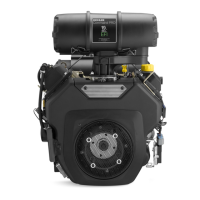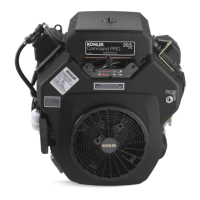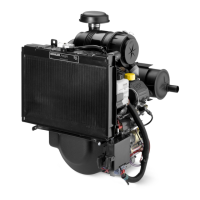6524 690 01 Rev. K KohlerEngines.com
EFI SYSTEM-BOSCH
7. Locate service connector plug in wiring harness.
“35 Pin” (MA 1.7) Metal-Cased ECU: Connect a
jumper wire from TPS initialization pin #8 (gray
wire) to ground pin (black wire), or use jumper
plug with red jumper wire.
“24 Pin” (MSE 1.0) Plastic-Cased ECU:
Connect a jumper wire from TPS initialization pin
#24 (violet wire) to battery voltage pin (red wire),
or use jumper plug with blue jumper wire.
8. Hold throttle against idle speed stop screw, turn
ignition switch to “ON” position (do not start engine),
and observe Malfunction Indicator Light (MIL).
a. Light should blink on/off quickly for approximately
3 seconds and then go off and stay off, indicating
initialization procedure has been successful.
b. If light stays on or blinking ceases prematurely,
procedure was unsuccessful and must be
repeated. Possible causes for unsuccessful
learning may be: 1) Movement occurred in either
TPS or throttle shaft during procedure, 2)
Crankshaft movement/rotation was detected by
speed sensor during procedure, 3) Throttle plate
position was out of learnable range (recheck 1500
RPM idle speed adjustment), or 4) Problem with
ECU or TPS.
9. When initialization procedure has been successfully
completed, turn off key switch, remove jumper wire
or connector, and remove rubber band from throttle
lever.
10. Disconnect negative (-) battery cable temporarily to
clear all learned adjustments.
11. Reconnect battery cable and all external loads.
Readjust idle speed to equipment manufacturer’s
specifi ed setting and recheck high-speed, no-load
RPM setting. Observe overall performance.
TPS Initialization Procedure
For“32 Pin” (MSE 1.1) Plastic-Cased ECU Only (“Auto-
Learn” Initialization)
1. Check that basic engine, all sensors, fuel, fuel
pressure, and battery are good and functionally
within specifi cations.
Important!
2. Remove/disconnect ALL external loads from engine
(belts, pumps, electric PTO clutch, alternator,
rectifi er-regulator, etc.).
3. Locate service connector plug in wiring harness. To
initiate TPS auto-learn function, connect a jumper
wire from TPS initialization pin #24 (violet wire) to
battery voltage pin (red wire), or use jumper plug
with blue jumper wire. If using PC-based diagnostic
tool and software, refer to Special Tests in Tools/Aids
and follow prompts to complete.
4. Start engine and immediately observe Malfunction
Indicator Light (MIL). Light should start blinking 4
consecutive times every 2 seconds.
5. Remove jumper wire or plug from service connector
plug in wiring harness.
6. Run engine at full throttle (above 3000 RPM), to
warm up engine and initiate O
2
sensor function in
“closed-loop” operation.
7. Watch MIL. When light starts blinking rapidly, (5
blinks per second), move throttle lever to low idle
speed position. Check and adjust idle speed to 1500
RPM, using a tachometer. Lamp should continue to
blink rapidly for another 30 seconds before switching
to a slow blink.
8. When MIL blinks slowly, do not do anything but wait
until MIL shuts off. This indicates that this procedure
has been completed successfully.
9. Shut off engine.
If learn procedure was successfully completed,
external loads removed/disconnected in Step 2
may be reconnected.
If procedure was unsuccessful see Steps a. and
b. following.
a. If during this procedure, MIL goes back into
blinking 4 consecutive blinks every 2 seconds,
engine and O
2
sensor have cooled down and
out of “closed-loop” operation, prohibiting
learning from occurring. Repeat Steps 6-9.
b. If during procedure with engine running, MIL
stays ON continuously, for more than 15
seconds, turn off ignition. Then initiate fault
code sequence, by doing three consecutive
key-on/key-off cycles leaving key “ON” in last
sequence, (each key-on/key-off sequence must
be less than 2.5 seconds long). Fault detected
must be corrected before auto-learn function
can be re-initiated. PC-based diagnostic tool
and software may be used to read out fault
code and assist with troubleshooting and repair.
Temperature sensor is a sealed, non-serviceable
assembly. A faulty sensor must be replaced. If a blink
code indicates a problem with temperature sensor, it can
be tested as follows:
1. Remove oil temperature sensor from adapter
housing and cap or block adapter hole.
2. Wipe sensor clean and allow it to reach room
temperature (20°C, 68°F).
3. Unplug main harness connector from ECU.
4. With sensor connected, check oil temperature
sensor circuit resistance. Value should be 2375-
2625 . See chart on pages
“35 Pin” (MA 1.7) Metal-Cased ECU: Check
between #14 and #27 pin terminals.
“24 Pin” (MSE 1.0) Plastic-Cased ECU: Check
between #6 and #4 pin terminals.
“32 Pin” (MSE 1.1) Plastic-Cased ECU: Check
between #6 and #4 pin terminals.

